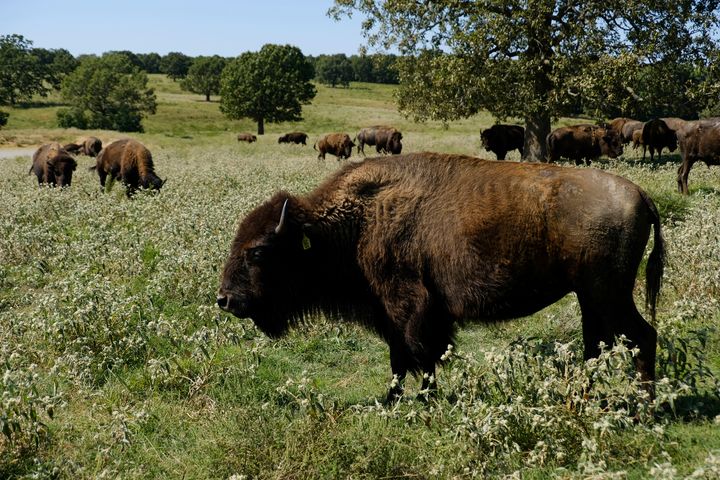A bipartisan bill proposed Friday would require the Interior Department to create a permanent program to support tribal governments’ ongoing efforts to reestablish wild bison herds.
Proposed by Sens. Martin Heinrich (D-N.M.) and Markwayne Mullin (R-Oka.), the bill would mark a major step toward confronting one of America’s most glaring wildlife conservation failures.
The program would allocate $14 million annually toward efforts to shuttle wild buffalo from federal public land to tribal reservations. It would also offer grants and technical assistance to help tribal efforts to expand buffalo habitat.
“The bison has been a critical part of our culture for many generations, in New Mexico, across the West, and especially in Indian Country,” Heinrich said in a statement. “The growth of Tribal buffalo herds over the last few decades is both a symbol of the enduring resilience of this iconic species and a major economic development opportunity … I hope that within my lifetime—thanks to a broad coalition—we will see bison return to the prominent place they once occupied as the keystone species on American shortgrass prairies.”
Leaders of the Inter-Tribal Buffalo Council, an 82-nation coalition working to restore wild bison to tribal lands, applauded the bill.
“It is simply impossible to overstate both the importance of the buffalo to the Indian people and the damage that was done when the buffalo were nearly wiped out,” ITBC President Ervin Carlson said in a statement. “By helping tribes reestablish buffalo herds on our reservation lands, the Congress will help us reconnect with a keystone of our historic culture as well as create jobs and an important source of protein that our people truly need.”
This will be the third time the bill appears before Congress. Former Rep. Don Young (R-Alaska), who died last year, first proposed a version of the law in 2019.
Audrey Jackson/Associated Press
Over the last three decades, tribal governments have increasingly sought to reestablish wild herds on reservation land, often working with Yellowstone National Park to transport animals that federal officials would otherwise cull.
For tribes that historically lived alongside wild buffalo, the animal’s return has spurred a unique movement combining social justice, cultural restoration and wildlife conservation.
In July, the Blackfeet Nation took the historic step of releasing wild bison onto tribal land, where they will almost certainly end up migrating toward Glacier National Park, setting the stage for one of the farthest-reaching buffalo restoration efforts in decades.
But the push to bring buffalo back to tribal land also faces major obstacles.
The Yellowstone buffalo population has high rates of brucellosis, a bacterial disease that causes miscarriage and impedes weight gain. Moving the animals around or expanding their range often draws strong opposition from ranchers, a major political force in western states like Montana, who fear the disease could spread to cattle.
Most reservations also lack the land base to build back big herds — largely a result of federal land privatization policies dating back to the Dawes Act of 1887. The law imposed a homestead-like system on tribes called “allotment,” then opened up unallotted tribal land to white homesteaders.
With that legacy, expanding buffalo habitat often requires buying new land or working with ranchers to retire cattle grazing rights.
Estimates of North America’s wild buffalo herds prior to European colonization range from 30 million to 60 million animals. Fewer than half a million remain today, with the vast majority of them living on commercial ranches. Only about 20,000 bison remain in wild conservation herds today.
“Buffalo are as ubiquitous to the land as the Indigenous peoples that have resided here for thousands of years,” ITBC board member Jason Baldes said in a statement. “The species is necessary to not only heal the land but to revive and protect our culture and maintain connection to our ancestral heritage.”


